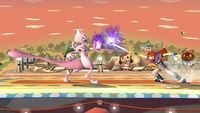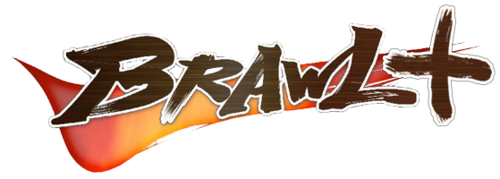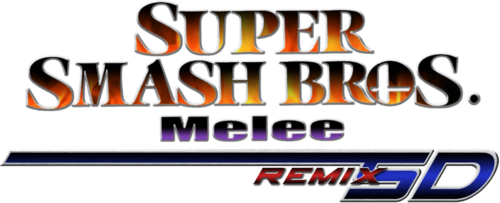Gameplay modification: Difference between revisions
No edit summary Tag: Mobile edit |
Wolfy76700 (talk | contribs) |
||
| Line 5: | Line 5: | ||
==Overview== | ==Overview== | ||
[[File:ProjectMRoyVsMewtwo.jpg|thumb|left|{{PM|Mewtwo}} and {{PM|Roy}} square off in ''Project M''. The addition of new characters to mods is a new trend.]] | |||
Gameplay modifications for the games are intended to, as their name implies, modify how the actual gameplay works. Specific changes to the game depend on the preferences of the developers, as well as their ultimate goal. ''[[Brawl+]]'', for instance, intended to make ''Brawl'' competitive by making its gameplay more similar to ''Melee'', while ''[[Brawl-]]'' overhauls the physics engine and adds significant buffs to all playable characters. Despite the differences in final goals, gameplay mods are generally intended to reduce [[tier list|competitive inequality between characters]]. | Gameplay modifications for the games are intended to, as their name implies, modify how the actual gameplay works. Specific changes to the game depend on the preferences of the developers, as well as their ultimate goal. ''[[Brawl+]]'', for instance, intended to make ''Brawl'' competitive by making its gameplay more similar to ''Melee'', while ''[[Brawl-]]'' overhauls the physics engine and adds significant buffs to all playable characters. Despite the differences in final goals, gameplay mods are generally intended to reduce [[tier list|competitive inequality between characters]]. | ||
[[File:BrawlMinusTemple.jpg|thumb|right|An example of a gameplay mod. In ''Brawl-'', the stage [[Temple]] has been significantly condensed compared to its vanilla counterpart.]] | [[File:BrawlMinusTemple.jpg|thumb|right|An example of a gameplay mod. In ''Brawl-'', the stage [[Temple]] has been significantly condensed compared to its vanilla counterpart.]] | ||
[[File:ProjectM Skyloft.png|thumb|right|In [[Project M]], the same stage layout was used to make the Skyloft stage.]] | |||
In addition to raw gameplay, other portions of the game may be overhauled by developers to further change gameplay. The changing of stages is among the more common ways to do this; ''Brawl-'', for instance, replaces the ordinarily over-sized [[Temple]] with a smaller, more condensed version. Outside of this, unpopular stages might be entirely replaced with others, such as how ''Project M'' replaces the highly non-standard [[Mario Bros.]] with a rendition of [[Fountain of Dreams]] from ''Melee''. | In addition to raw gameplay, other portions of the game may be overhauled by developers to further change gameplay. The changing of stages is among the more common ways to do this; ''Brawl-'', for instance, replaces the ordinarily over-sized [[Temple]] with a smaller, more condensed version. Outside of this, unpopular stages might be entirely replaced with others, such as how ''Project M'' replaces the highly non-standard [[Mario Bros.]] with a rendition of [[Fountain of Dreams]] from ''Melee''. | ||
Stages are not the only method to altering the gameplay of the individual games. While a relatively new trend, the addition of characters has become a possibility for those interested in gameplay mods. ''Project M'' notably added [[Roy]] and [[Mewtwo]] as playable characters after the absence of the duo in ''Brawl'', with ''Brawl-'' later following suit and reintroducing [[Pichu]] to the game. | Stages are not the only method to altering the gameplay of the individual games. While a relatively new trend, the addition of characters has become a possibility for those interested in gameplay mods. ''Project M'' notably added [[Roy]] and [[Mewtwo]] as playable characters after the absence of the duo in ''Brawl'', with ''Brawl-'' later following suit and reintroducing [[Pichu]] to the game. | ||
Revision as of 05:46, November 23, 2014
In addition to cosmetic hacks such as file replacement, modifications to the gameplay of individual games, shorthanded to mods, have become a widespread phenomenon within the hacking community. The first attempts at modding the gameplay of Brawl were viewed as novelties, not unlike the modification of palette swaps for characters; outside of this, forcing the Wii to load such mods was considered difficult, requiring use of the now-inoperable Twilight hack. The increasing complexity of gameplay mods and the discovery of the Smash Stack exploit, however, caused the mods to develop considerably more attention with observers.
Within the hacking community, the base game is often referred to as vBrawl or vMelee as a contraction for Vanilla Brawl or Vanilla Melee; the term "vanilla" comes from a common terminology featured in the computing world.
Overview
Gameplay modifications for the games are intended to, as their name implies, modify how the actual gameplay works. Specific changes to the game depend on the preferences of the developers, as well as their ultimate goal. Brawl+, for instance, intended to make Brawl competitive by making its gameplay more similar to Melee, while Brawl- overhauls the physics engine and adds significant buffs to all playable characters. Despite the differences in final goals, gameplay mods are generally intended to reduce competitive inequality between characters.
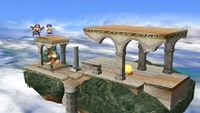
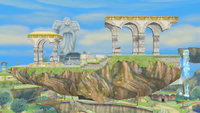
In addition to raw gameplay, other portions of the game may be overhauled by developers to further change gameplay. The changing of stages is among the more common ways to do this; Brawl-, for instance, replaces the ordinarily over-sized Temple with a smaller, more condensed version. Outside of this, unpopular stages might be entirely replaced with others, such as how Project M replaces the highly non-standard Mario Bros. with a rendition of Fountain of Dreams from Melee.
Stages are not the only method to altering the gameplay of the individual games. While a relatively new trend, the addition of characters has become a possibility for those interested in gameplay mods. Project M notably added Roy and Mewtwo as playable characters after the absence of the duo in Brawl, with Brawl- later following suit and reintroducing Pichu to the game.
Outside of these gameplay changes, gameplay mods may feature a variety of cosmetic changes to Brawl. Some tracks may be replaced, particularly in the case of original stages, and some characters may be given palette swaps that reference works not previously featured in Brawl.
Due to the Smash Stack exploit and relative ease of hacking the Wii compared to the GameCube, modifications for Brawl are considerably more widespread than those for Melee, though a small, devoted hacking scene for Melee has developed, with Melee: SD Remix being the most popular of these mods. Because of the difficulty of hacking the Nintendo 64 and a lack of demand because of a smaller community, no notable hacks for Smash 64 have been produced.
Notable gameplay mods
Balanced Brawl
Balanced Brawl is unusual amongst Brawl mods in that it does not significantly alter the core gameplay physics of Brawl. In its attempts to make the game more balanced, it instead primarily focuses buffing and nerfing all the characters, as well as adding some universal nerfs, such as altering how ledges work in order to combat planking. In addition to its various character tweaks, some of the stages were also changed, though not to an extent seen in other mods; most stage hazards are still present, but instead are either weakened or occur less often. Likely as a result of its lack of immediately visible changes, Balanced Brawl was unable to find the popularity of other mods for Brawl, though it did attain a small niche composed of those who opposed the changes made by Brawl+.
While not officially abandoned, the last notable update for Balanced Brawl, version 3, was released in 2010, with only a 2011 bugfix patch for PAL regions being released since then. Because of the effectively ceased development, Balanced Brawl is generally considered to be antiquated. As its last version was based on the Brawl metagame from 2010, some notable developments are not reflected in Balanced Brawl, such as the emergence of Captain Olimar as a top tier character, as well as the gradually decreasing dominance of Snake.
Brawl-
Brawl-, like most other Brawl mods, attempts to change the cast and physics of Brawl in order to make the game more balanced. As a farcical jab to the then-concurrent mod of Brawl+ and its careful use of appropriate nerfs and buffs, the changes to the characters and physics in Brawl- are intended by the developers to be absurd and over-the-top in comparison; Brawl-'s development has relied on the mantra of "if everyone is broken, no one is". Hitstun, for instance, has been drastically increased as to allow for combos that are much easier to perform than either Brawl or Melee and all characters now have the ability to wall jump. In addition, instead of giving characters a mix of appropriate buffs and nerfs to balance the cast, all the characters have been buffed to ridiculous levels and each given a plethora of new, very powerful options; Ike, for instance, can use Eruption to enter "No Sympathy Mode", which boosts his damage output while also inflicting damage to him every time he attacks with his sword. The mod is noteworthy for being the only major Brawl mod aimed towards casual players instead of competitive players, though the mod is still intended to have competitive balance.
Brawl- enjoyed considerable popularity and attention when first released in 2010, and it became the most popular Brawl mod among the fanbase in this time, due to its more obvious changes compared to Balanced Brawl and its less controversial changes compared to Brawl+. As Project M got farther into development and started releasing more complete builds, however, Brawl- would become eclipsed in popularity, though it still has a large, devoted cult following. Despite the diminishing popularity and lack of representation at tournaments, development for Brawl- continues to this day, with builds being released into 2014; one recent build, version 3.3, added Pichu to the playable cast.
Brawl+
Brawl+ was the first notable gameplay mod available for Brawl, and it also became the first mod to develop its own tournament scene, though such tournaments were not recognised as official. The mod featured multiple tweaks to gameplay that would later be seen in most future mods; in addition to changing the physics engine, some stages were changed in order to make them fit the guidelines for legality within tournaments, and individual characters had various attributes nerfed and buffed in an attempt to reduce competitive inequality between characters. Despite popularising the concept of modifying the base gameplay of Brawl, Brawl+ was immediately controversial to some members of the community, due to the fact that most of its changes were seen by many as solely attempting to make Brawl play exactly like Melee, particularly in regard to changes to individual characters, such as Fox and Jigglypuff having become altered to make them almost identical to their Melee counterparts. Brawl+'s own staff became estranged and antagonistic towards each other because of controversies over the development and ultimate goal of the mod.
Development of the mod ceased in 2010, with version 7.0.3. Most of its staff moved onto Project M, a mod with a similar design philosophy to Brawl+, but with a more concentrated and slightly different goal. Today, Brawl+ is mostly viewed as a curiosity amongst Smashers who are interested in seeing how the hacking scene of Brawl first started.
Melee: SD Remix
Melee: SD Remix is the most notable of hacks involving Melee. While hacking the GameCube is comparatively more difficult than the Wii, the hack still holds some niche appeal amongst some devoted Melee players. The concept behind Melee: SD Remix can be compared to that of Balanced Brawl; both mods avoid making changes to to the game's base engine in favour of buffing and nerfing individual attributes of characters to make the game more balanced. Some stages have also been altered as to allow for better competitive gameplay.
Development for Melee: SD Remix has continued to the present day, with version 3.0 being under development.
Project M
Project M can be seen as a spiritual successor to Brawl+, due to the two mods sharing much of the identical staff. Project M features many of Brawl+'s previous physics changes, but was able to distance itself from the previous mod and its related controversies by giving more thorough changes to all characters. Of all Brawl gameplay mods, Project M remains the most popular, due to its altered physics engine that makes it play similarly to Melee and thorough nerfing and buffing of all characters in the game; although aimed primarily at hardcore players as opposed to casual gamers, Project M's considerable "fanservice", such as the inclusion of Roy and Mewtwo, new palette swaps that reference more video games than Brawl's standard selections, and other such interests have allowed it to reach popularity amongst such players. Project M's popularity led to it eventually becoming a notable side-event in tournaments, and it later developed its own distinctive tournament scene, with Apex 2014's Project M event attracting even more entrants than Brawl's.
While version 3.0 of Project M marked its final notable release, development of the mod has continued, primarily to address bugs and to improve performance of the mod.
External links
Smash Mods, a forum devoted to discussing and improving various gameplay modifications.
